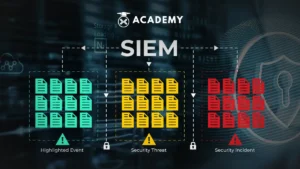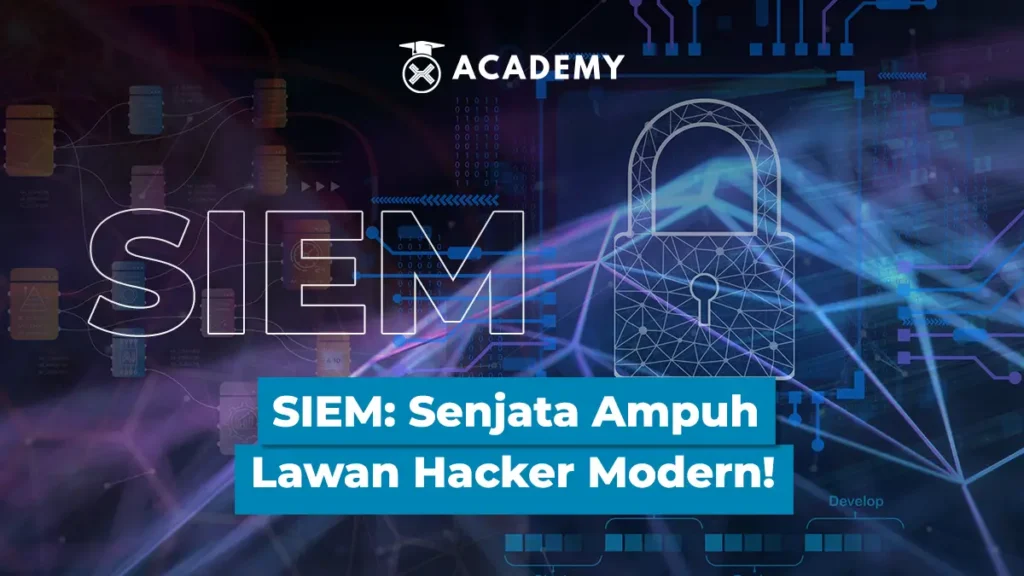Cyber ??attacks are getting more and more sophisticated. Many businesses, especially those just starting to go digital, are unaware that suspicious activity on their network can be an early sign of a hacker attack.
This is where SIEM plays an important role. More than just a monitoring tool, SIEM is a system that can detect, analyze, and respond to cyber threats in real-time.
However, how does it work? And why is SIEM increasingly needed in today’s digital era? Let’s take a look at the following review.
What is SIEM?

SIEM or Security Information and Event Management is a security system designed to monitor, analyze, and respond to cyber threats in real-time.
SIEM works by collecting logs from various devices and systems in IT infrastructure, such as firewalls, servers, applications, databases, and other network devices. From this log data, SIEM begins to act.
This system not only stores logs as archives, but also analyzes every recorded event to detect suspicious activity, from unusual login attempts to strange network traffic patterns.
This process allows security teams to more quickly recognize potential attacks before they disrupt business operations.
SIEM is a combination of two main technologies, namely Security Information Management (SIM) and Security Event Management (SEM).
SIM focuses on collecting and storing logs, while SEM is tasked with analyzing and responding to security events.
The combination of the two creates a platform that is able to provide comprehensive visibility into an organization’s security posture.
SIEM is also equipped with advanced features such as user behavior analysis, artificial intelligence (AI), and machine learning that can detect threat patterns automatically.
In fact, some modern SIEM systems can take immediate action, such as disconnecting devices suspected of being compromised, to prevent further damage.
In the increasingly complex digital threat landscape, SIEM is the backbone of security operations centers (SOCs) in detecting incidents, managing responses, and conducting forensic investigations.
Not only that, this system also helps companies meet various data security regulations, such as ISO 27001 and GDPR, by providing complete logging for audit and compliance purposes.
In essence, SIEM is not just a monitoring tool, but a system that unites various layers of security defense into one intelligent and responsive control center.
Main Components in SIEM
To be able to perform its functions optimally, SIEM consists of several main components that are integrated with each other, including the following:
1. Log Management
SIEM collects logs from various sources such as servers, firewalls, applications, and other network devices. The purpose of this collection is to capture all activities in the system, including network traffic and system events.
This log is the main ingredient for detecting anomalies and potential threats. Some SIEM systems are even connected to external threat intelligence to provide additional context.
2. Event Correlation
After the logs are collected, SIEM will analyze and connect various seemingly unrelated activities to find suspicious patterns.
For example, repeated failed login attempts from one location followed by unauthorized access from a different IP. This kind of correlation helps uncover potential attacks that might not be visible if only one event is viewed separately.
3. Real-time Monitoring
SIEM monitors the system continuously for 24 hours. Every activity recorded is analyzed in real-time and displayed on a central dashboard.
This non-stop monitoring allows the security team to respond quickly to threats before they impact the system further.
4. Threat Detection
SIEM is equipped with advanced analysis capabilities, such as behavioral modeling and pattern detection, to identify abnormal activity as quickly as possible.
Some systems even use AI and machine learning to recognize early signs of attacks that might otherwise go unnoticed by humans.
5. Incident Response
When SIEM detects a threat, it can send an alert or immediately run an automated response according to pre-defined rules.
For example, if a malicious program is detected, SIEM can automatically disconnect the infected device. This automated response helps speed up handling and reduce the workload of the security team.
Also read related articles: Crypto Crime Risks for Indonesian Traders in 2025
How SIEM Works
SIEM systems are designed to identify, monitor, and respond to cybersecurity threats by combining security information management (SIM) and security event management (SEM). Here are the stages of how it works, namely:
1. Data Collection
SIEM starts working by collecting data from various sources across the IT infrastructure, such as endpoint devices, servers, applications, firewalls, antivirus systems, clouds, to network devices such as routers and switches.
The log data collected includes user activity, configuration changes, to network traffic. This process can be carried out in a distributed manner with the help of edge collectors before being sent to the storage center.
2. Normalization
The data collected has various formats depending on the source. SIEM then performs normalization to unify the data in a standard format that can be analyzed.
This allows data from different operating systems, cloud applications, and other security devices to be processed uniformly. The results of this normalization also speed up analysis and facilitate threat pattern mapping.
3. Correlation Engine (Correlation and Analytics)
With the help of correlation engine, SIEM analyzes data to find relationships between events. For example, if a suspicious login is followed by an unusual data transfer, the system can conclude that an attack is likely.
This correlation of events is key to detecting hidden threats that are not visible when viewed individually. This process is greatly assisted by the integration of AI and machine learning.
4. Alert Generation (Alert Generation)
When SIEM detects a suspicious pattern or rule violation, the system immediately generates an alert in real-time. This alert is sent to the security team via a centralized dashboard.
Real-time data visualization on the dashboard makes it easy for analysts to identify spikes or anomalous activity that requires further investigation.
5. Response Automation (Response Automation)
Some modern SIEM solutions already come with automated response capabilities based on predefined policies.
For example, if it detects malware, SIEM can immediately isolate the related endpoint from the network without manual intervention. This automation helps speed up response time (MTTR) and reduce the workload of the security team.
SIEM Benefits for Data Security
Security Information and Event Management (SIEM) is an essential tool in a modern cyber defense strategy.
Its implementation can strengthen security systems, improve operational efficiency, and speed up the incident investigation process. Here are some of the main benefits of SIEM, including:
1. Faster & more accurate threat detection
SIEM utilizes artificial intelligence and cross-system data correlation to detect suspicious patterns in real-time.
This capability enables security teams to identify and anticipate attacks before they develop into serious threats.
2. Increase visibility of activity across the network
By combining and analyzing data from multiple sources such as endpoints, cloud applications, and internal servers, SIEM provides a comprehensive view of network activity, including remote access points and BYOD devices.
3. Accelerate response to attacks before they have a major impact
SIEM’s automation and real-time notification features make it easy for security teams to take quick action on incidents, thereby minimizing system damage and reducing potential financial losses.
4. Assisting digital forensics and incident investigations
SIEM enables long-term log data storage and in-depth analysis of digital footprints. This facilitates the post-incident investigation process, reconstructs the chronology of events, and detects perpetrators or security vulnerabilities.
5. Supports security audits and regulatory compliance
With automated reporting and centralized auditing capabilities, SIEM helps organizations meet regulatory standards such as ISO 27001, GDPR, or PCI-DSS.
Security event documentation is also easier to access and prepare when needed.
You might also be interested in this: : Understanding Data Crime Doxing: These Are the Dangers & How to Avoid Them
When Should You Use SIEM?

Security Information and Event Management (SIEM) should be used when a business experiences significant growth, especially when it starts to rely on various digital systems for daily operations.
In situations like this, the amount of data and potential security gaps will increase.
SIEM is present as a solution that is able to monitor all network activities comprehensively and centrally so that threats can be detected early.
The use of SIEM is also highly recommended when a company already has an IT team or even an internal Security Operation Center (SOC).
With the support of a security team, SIEM can be optimally utilized to respond to threats in real-time, reduce the impact of risks, and increase the efficiency of incident handling.
As companies begin to expand, both geographically and digitally, the need for extra protection against external attacks also increases.
This is where the role of SIEM becomes crucial. This system is able to filter complex data traffic, identify suspicious activity, and provide early warnings before threats actually damage the infrastructure.
In addition, SIEM is also needed to meet various industry security and compliance standards such as PCI-DSS, HIPAA, and other regulations.
This system not only helps in collecting relevant log data but also simplifies the audit and reporting process.
Examples of Popular SIEM Tools
The following are some popular SIEM (Security Information and Event Management) tools that are widely used by various organizations, from large companies to government institutions, including:
1. IBM QRadar
IBM QRadar is one of the SIEM solutions most widely adopted by large-scale companies.
This tool is designed to provide in-depth security analysis, and is able to manage very large volumes of log data from various devices and systems.
QRadar is suitable for companies with internal SOCs because it is able to detect complex attacks, provide real-time alerts, and support forensic investigations.
2. Splunk
Splunk is known for its flexibility and strength in data analytics. This solution allows integration with various IT platforms and applications, and provides interactive visualization of log and security data.
Splunk is perfect for organizations that prioritize data intelligence and need very detailed security monitoring.
In addition to being a SIEM, Splunk is also often used for observability and operational analytics, making it a multifunctional solution in modern IT environments.
3. LogRhythm
LogRhythm excels in automating security processes and threat detection. One of its flagship features is SmartResponse™, which enables automated responses when threats are detected.
As a result, the incident handling process by the security team becomes faster and more focused. LogRhythm also offers an intuitive user interface, making it easy to navigate and use.
Equipped with powerful analysis tools, this tool greatly supports the effectiveness of the security team. Suitable for organizations that want to improve SOC operational efficiency without relying on many separate tools.
4. Microsoft Sentinel
As a cloud-based SIEM solution, Microsoft Sentinel is deeply integrated with Microsoft Azure services.
Sentinel is ideal for companies that use Microsoft cloud services, because it can monitor, analyze, and respond to threats from all cloud-based digital environments efficiently.
With the support of artificial intelligence and machine learning, Sentinel can provide smarter threat detection and reduce the number of false positives that often burden security teams.
5. ArcSight
ArcSight is a SIEM tool that has long been trusted by various government agencies and large companies in the enterprise sector.
ArcSight offers a powerful solution for log correlation, compliance reporting, and in-depth analysis of security threats.
Its advantages lie in its high scalability and ability to handle complex IT environments. Suitable for the needs of strict security control and regulatory reporting.
Another interesting article for you: Revealing the Dangers of Brute Force Attacks: Peek at the 5 Best Defense Strategies
Brief Case Study
For example, an e-commerce company in Indonesia experienced a spike in failed login activity, especially from overseas IP addresses. With the help of a SIEM solution, this anomalous pattern was immediately detected as a potential brute force attack.
SIEM automatically sent an alert to the security team, who immediately took action by blocking access in less than three minutes.
SIEM’s ability to detect and respond to threats has proven effective, even for fairly complex attacks.
In addition, the collected log data allows the team to conduct forensic analysis, understand attack paths, and evaluate system vulnerabilities.
If not handled quickly through SIEM, this incident has the potential to cause customer data leakage and impact the company’s compliance with data protection regulations.
Conclusion
Well, that was an interesting discussion about SIEM: A Powerful Weapon Against Modern Hackers! which you can read in full at the Crypto Academy at INDODAX Academy.
In conclusion, SIEM is not just a log recording tool, but the control center of a modern network security system.
With the ability to detect threats faster, provide automated responses, and provide complete visibility into system activity, SIEM is a vital component in cyber defense.
If you really want to protect your digital assets, whether in business, financial services, or crypto platforms, then adopting SIEM is a decision that cannot be postponed.
Basically, in a digital world full of risks, SIEM is the front guard you need.
In addition to expanding your investment and technology security insights, you can also stay updated with the latest crypto news and monitor the price movements of digital assets directly on the INDODAX Market. Don’t forget to activate notifications so that you always get the latest information about digital assets and blockchain technology only at INDODAX Academy.
You can also follow our latest news via Google News for faster and more reliable access to information. For an easy and safe trading experience, download the best crypto application from INDODAX on the App Store or Google Play Store.
Also maximize your crypto assets with the INDODAX Earn feature, a practical way to earn passive income from the assets you store.
Also follow our social media here: Instagram, X, Youtube & Telegram
FAQ
1.What is SIEM and what is its function?
SIEM stands for Security Information and Event Management, used to monitor and analyze log data to detect cyber threats.
2. Is SIEM suitable for small businesses?
Suitable, especially if your business is starting to grow and uses a lot of digital systems.
3.What is the difference between SIEM and antivirus?
Antivirus protects individual devices. SIEM protects the network and the entire system as a whole.
4.SIEM works manually or automatically?
The majority of SIEM functions work automatically, including detecting and providing alerts when there is a threat.
5.Is SIEM only used by technology companies?
No. Many sectors such as banking, health, and government also rely on SIEM.
Author: Boy






 Polkadot 8.91%
Polkadot 8.91%
 BNB 0.54%
BNB 0.54%
 Solana 4.81%
Solana 4.81%
 Ethereum 2.37%
Ethereum 2.37%
 Cardano 1.35%
Cardano 1.35%
 Polygon Ecosystem Token 2.11%
Polygon Ecosystem Token 2.11%
 Tron 2.85%
Tron 2.85%
 Market
Market


